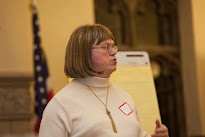When I was studying Community Organizing at UConn one of the things that they drummed into us was…
Go for the movable center.For our supporters thank them! And encourage them.For those who are opposed to us, be polite and tell them that you think they are wrong… then walk away.
I have changed may people’s minds. This picture is of me talking at a town hall for marriage equality and the gender inclusive non-discrimination bill. We were speaking at UConn School of Law and I gave my talk. Afterward, two women came up to me and said we thought that battle was over with marriage equality but listening to you we realized that there is much more work that is needed to be done.
Back in the 50s and 60s the gays and lesbians, it was all about assimilation… see we are just like you!
But being swept aside were the drag queens, the flaming gays, and the trans people. We were not about assimilation… we were about being ourselves. But all that changed on June night in 1969.
So how did we go from being the dregs of society that not even the gays and lesbians wanted to associate with us to passing marriage and non-discrimination laws?
I went around to different places in Connecticut pitching marriage equality with Love Makes a Family and the gender inclusive non-discrimination bill. We went wherever they wanted to hear us, I'll tell a you going to a business club to talk to a bunch of conservative business people was very interesting… I think that we changed a couple of minds.
The Milwaukee Independent writes about Harvey Milk,
In the late 19th and early 20th century, gay subculture thrived in many large American cities. Gay men spoke of “coming out” into gay society – borrowing the term from debutante society, where elite young women came out into high society. A 1931 news article in the Baltimore Afro-American referred to “the coming out of new debutantes into homosexual society.” It was titled “1931 Debutantes Bow at Local ‘Pansy’ Ball.”The 1930s, 1940s and 1950s witnessed a growing backlash against this visible gay world. In response, gay life became more secretive. The Mattachine Society, the earliest important organization of what was known as the homophile movement – a precursor of the gay rights movement – took its name from mysterious medieval figures in masks. In this context, coming out meant acknowledging one’s sexual orientation to oneself and to other gay people. It did not mean revealing it to the world at large.
Then along came Harvey Milk…
For instance, in 1978, in his campaign to defeat a California initiative that would have banned gay teachers from working in state public schools, openly gay elected government official Harvey Milk urged people to “Come Out, Come Out, Wherever You Are.”Milk gambled that if queer people told their friends they were gay, Californians would realize that they had friends, coworkers and family members who were gay and – out of solidarity – would oppose the proposition. The campaign helped defeat the initiative.
And you know what? It worked!
When someone knows a trans person they are supportive of our rights!
I will say it again, our stories moves mountains! 48In48 writes about it in “Telling Stories That Inspire Activism: 4 Best Practices”
Where only 5% of people remember statistics, 63% remember the stories they hear. Storytelling is powerful, especially when it comes to spreading awareness and inspiring action. That’s why organizations of all shapes and sizes turn to storytelling to promote their activism — whether they’re educating the public about a disease, encouraging supporters to vote, or petitioning for the passage of a law.
Did you get that?
Telling true stories without embellishment is a fundamental rule of ethical nonprofit storytelling. Being authentic is how you earn the trust of new and existing supporters alike and inspire them to act.
Telling my story at that town hall meeting changed those to lesbians, the movable middle!
Testifying!
No way will do that.
But that is what I thought and I did!
It is really nothing more than telling your story except it is before legislators, for me it was a little easier the first times… one of the co-chairs told me to relax. You see I had already met them at a fund raiser for Gender PAC. We sat around in a friend’s living chatting with the co-chairs and the future governor.
Did you notice something along the lines of “Telling Our Stories? We need to get out there and mingle with politicians, it came in handy in the future when I testified by the Judicial Committee.
Over the years I wrote down what I have learned from testifying.
Your homework: Read Chapter 8 of the Community Tool Box, read Saul Alinsky’s 12 Rules for Radicals and my rules for testifying. Next week I ask you if Alinsky's rule do you know anyone who uses them?
And next week I'll tell you a story about reading the 12 Rules for Radicals for class.

No comments:
Post a Comment